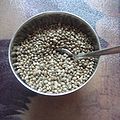Hemp oil

| Part of a series on |
| Cannabis |
|---|
 |
Hemp oil (hemp seed oil or hempseed oil) is obtained by pressing hemp seeds. Cold pressed, unrefined hemp oil is dark to clear light green in color, with a nutty flavor. The darker the color, the grassier the flavour. It should not be confused with hash oil, a tetrahydrocannabinol-containing oil made from the Cannabis flower.
Description
Refined hemp seed oil is clear and colorless, with little flavor. It is primarily used in body care products. Industrial hemp seed oil is used in lubricants, paints, inks, fuel, and plastics. Hemp seed oil is used in the production of soaps, shampoos and detergents. The oil has a 3:1 ratio of omega-6 to omega-3 essential fatty acids.[1] It may also be used as a feedstock for the large-scale production of biodiesel.[2]
Manufacture
Hemp seed oil is manufactured from varieties of Cannabis sativa that does contain significant amounts of tetrahydrocannabinol (THC), the principal psychoactive element present in the cannabis plant. This manufacturing process typically includes cleaning the seed to 99.99% before pressing the oil. There is THC within the hemp seed, amounts of THC may be found in hemp seed oil when plant matter adheres to the seed surface during manufacturing. The modern production of hemp seed oil, particularly in Canada, has successfully lowered THC values since 1998.[3] Regular accredited sampling of THC in Canadian hemp seed oil shows THC levels usually below detection limit of 4 ppm (parts per million, or 4 mg/kg). Legal limit for THC content in foodstuffs in Canada is 10 ppm.[4] Some European countries have limits of 5 ppm or none-detected, some EU countries do not have such limits at all.
Nutrition
About 49% of the weight of hempseed is an edible oil[5] that contains 76% as essential fatty acids; i.e., omega-6 fatty acids including linoleic acid (LA, 54%) and gamma-linolenic acid (GLA, 3%), omega-3 alpha-linolenic acid (ALA, 17%) in addition to monounsaturated fat (5% to 11%) and stearidonic acid (2%).[6] Hemp seed oil contains 5% to 7% saturated fat.[5][6] In common with other oils, hemp seed oil provides 9 kcal/g. Compared with other culinary oils it is low in saturated fatty acids.[6]
Hempseed oil has a relatively low smoke point and is not suitable for frying. Hemp seed oil is primarily used as a food oil and dietary supplement.
Comparison to other vegetable oils
| Type | Processing treatment[9] |
Saturated fatty acids |
Monounsaturated fatty acids |
Polyunsaturated fatty acids |
Smoke point | ||||
|---|---|---|---|---|---|---|---|---|---|
| Total[7] | Oleic acid (ω−9) |
Total[7] | α-Linolenic acid (ω−3) |
Linoleic acid (ω−6) |
ω−6:3 ratio | ||||
| Avocado[10] | 11.6 | 70.6 | 52–66 [11] |
13.5 | 1 | 12.5 | 12.5:1 | 250 °C (482 °F)[12] | |
| Brazil nut[13] | 24.8 | 32.7 | 31.3 | 42.0 | 0.1 | 41.9 | 419:1 | 208 °C (406 °F)[14] | |
| Canola[15] | 7.4 | 63.3 | 61.8 | 28.1 | 9.1 | 18.6 | 2:1 | 204 °C (400 °F)[16] | |
| Coconut[17] | 82.5 | 6.3 | 6 | 1.7 | 0.019 | 1.68 | 88:1 | 175 °C (347 °F)[14] | |
| Corn[18] | 12.9 | 27.6 | 27.3 | 54.7 | 1 | 58 | 58:1 | 232 °C (450 °F)[16] | |
| Cottonseed[19] | 25.9 | 17.8 | 19 | 51.9 | 1 | 54 | 54:1 | 216 °C (420 °F)[16] | |
| Cottonseed[20] | hydrogenated | 93.6 | 1.5 | 0.6 | 0.2 | 0.3 | 1.5:1 | ||
| Flaxseed/linseed[21] | 9.0 | 18.4 | 18 | 67.8 | 53 | 13 | 0.2:1 | 107 °C (225 °F) | |
| Grape seed | 10.4 | 14.8 | 14.3 | 74.9 | 0.15 | 74.7 | very high | 216 °C (421 °F)[22] | |
| Hemp seed[23] | 7.0 | 9.0 | 9.0 | 82.0 | 22.0 | 54.0 | 2.5:1 | 166 °C (330 °F)[24] | |
| High-oleic safflower oil[25] | 7.5 | 75.2 | 75.2 | 12.8 | 0 | 12.8 | very high | 212 °C (414 °F)[14] | |
| Olive (extra virgin)[26] | 13.8 | 73.0 | 71.3 | 10.5 | 0.7 | 9.8 | 14:1 | 193 °C (380 °F)[14] | |
| Palm[27] | 49.3 | 37.0 | 40 | 9.3 | 0.2 | 9.1 | 45.5:1 | 235 °C (455 °F) | |
| Palm[28] | hydrogenated | 88.2 | 5.7 | 0 | |||||
| Peanut[29] | 16.2 | 57.1 | 55.4 | 19.9 | 0.318 | 19.6 | 61.6:1 | 232 °C (450 °F)[16] | |
| Rice bran oil | 25 | 38.4 | 38.4 | 36.6 | 2.2 | 34.4[30] | 15.6:1 | 232 °C (450 °F)[31] | |
| Sesame[32] | 14.2 | 39.7 | 39.3 | 41.7 | 0.3 | 41.3 | 138:1 | ||
| Soybean[33] | 15.6 | 22.8 | 22.6 | 57.7 | 7 | 51 | 7.3:1 | 238 °C (460 °F)[16] | |
| Soybean[34] | partially hydrogenated | 14.9 | 43.0 | 42.5 | 37.6 | 2.6 | 34.9 | 13.4:1 | |
| Sunflower[35] | 8.99 | 63.4 | 62.9 | 20.7 | 0.16 | 20.5 | 128:1 | 227 °C (440 °F)[16] | |
| Walnut oil[36] | unrefined | 9.1 | 22.8 | 22.2 | 63.3 | 10.4 | 52.9 | 5:1 | 160 °C (320 °F)[37] |
Wood finish
Hemp oil is a "drying oil", as it can polymerize into a solid form. Due to its polymer-forming properties, hemp oil is used on its own or blended with other oils, resins, and solvents as an impregnator and varnish in wood finishing, as a pigment binder in oil paints, and as a plasticizer and hardener in putty.[citation needed]
Gallery
-
Bottles of hemp seed oil
-
Hemp seeds from which hemp seed oil can be extracted
See also
References
- ^ Callaway, J. C. (2004). "Hempseed as a nutritional resource: An overview". Euphytica. 140 (1–2): 65–72. doi:10.1007/s10681-004-4811-6.
- ^ Agua Das (November 16, 1997). "Hemp Oil Fuels & How to Make Them". HempFarm.com. Archived from the original on October 29, 2006. Retrieved November 18, 2006.
{{cite web}}: Unknown parameter|deadurl=ignored (|url-status=suggested) (help) - ^ Holler JM, Bosy TZ, Dunkley CS, Levine B, Past MR, Jacobs A (2008). "Delta9-tetrahydrocannabinol content of commercially available hemp products". J Anal Toxicol. 32 (6): 428–32. doi:10.1093/jat/32.6.428. PMID 18652749.
- ^ "Cannabis Hemp THC in the Food–Cosmetic Supply". drugwatch.org. Retrieved December 20, 2018.
- ^ a b "Basic Report: 12012, Seeds, hemp seed, hulled". USDA National Nutrient Database. April 2018. Archived from the original on February 22, 2019. Retrieved February 22, 2019.
{{cite web}}: Unknown parameter|deadurl=ignored (|url-status=suggested) (help) - ^ a b c "King's College Review of Nutritional Attributes of Cold Pressed Hemp Seed Oil" (PDF). Nutritional Sciences Division, King’s College, London. February 26, 2009.
{{cite web}}: Unknown parameter|authors=ignored (help) - ^ a b c "US National Nutrient Database, Release 28". United States Department of Agriculture. May 2016. All values in this table are from this database unless otherwise cited or when italicized as the simple arithmetic sum of other component columns.
- ^ "Fats and fatty acids contents per 100 g (click for "more details"). Example: Avocado oil (user can search for other oils)". Nutritiondata.com, Conde Nast for the USDA National Nutrient Database, Standard Release 21. 2014. Retrieved September 7, 2017. Values from Nutritiondata.com (SR 21) may need to be reconciled with most recent release from the USDA SR 28 as of Sept 2017.
- ^ "USDA Specifications for Vegetable Oil Margarine Effective August 28, 1996" (PDF).
- ^ "Avocado oil, fat composition, 100 g". US National Nutrient Database, Release 28, United States Department of Agriculture. May 2016. Retrieved September 6, 2017.
- ^ Ozdemir, Feramuz; Topuz, Ayhan (June 2004). "Changes in dry matter, oil content and fatty acids composition of avocado during harvesting time and post-harvesting ripening period". Food Chemistry. 86 (1): 79–83. doi:10.1016/j.foodchem.2003.08.012.
- ^ Wong M, Requejo-Jackman C, Woolf A (April 2010). "What is unrefined, extra virgin cold-pressed avocado oil?". Aocs.org. The American Oil Chemists' Society. Retrieved December 26, 2019.
- ^ "Brazil nut oil, fat composition, 100 g". US National Nutrient Database, Release 28, United States Department of Agriculture. May 2016. Retrieved September 6, 2017.
- ^ a b c d Katragadda, Harinageswara Rao; Fullana, Andrés; Sidhu, Sukh; Carbonell-Barrachina, Ángel A. (May 2010). "Emissions of volatile aldehydes from heated cooking oils". Food Chemistry. 120 (1): 59–65. doi:10.1016/j.foodchem.2009.09.070.
- ^ "Canola oil, fat composition, 100 g". US National Nutrient Database, Release 28, United States Department of Agriculture. May 2016. Retrieved September 6, 2017.
- ^ a b c d e f Wolke RL (May 16, 2007). "Where There's Smoke, There's a Fryer". The Washington Post. Retrieved March 5, 2011.
- ^ "Coconut oil, fat composition, 100 g". US National Nutrient Database, Release 28, United States Department of Agriculture. May 2016. Retrieved September 6, 2017.
- ^ "Corn oil, industrial and retail, all purpose salad or cooking, fat composition, 100 g". US National Nutrient Database, Release 28, United States Department of Agriculture. May 2016. Retrieved September 6, 2017.
- ^ "Cottonseed oil, salad or cooking, fat composition, 100 g". US National Nutrient Database, Release 28, United States Department of Agriculture. May 2016. Retrieved September 6, 2017.
- ^ "Cottonseed oil, industrial, fully hydrogenated, fat composition, 100 g". US National Nutrient Database, Release 28, United States Department of Agriculture. May 2016. Retrieved September 6, 2017.
- ^ "Linseed/Flaxseed oil, cold pressed, fat composition, 100 g". US National Nutrient Database, Release 28, United States Department of Agriculture. May 2016. Retrieved September 6, 2017.
- ^ Garavaglia J, Markoski MM, Oliveira A, Marcadenti A (2016). "Grape Seed Oil Compounds: Biological and Chemical Actions for Health". Nutrition and Metabolic Insights. 9: 59–64. doi:10.4137/NMI.S32910. PMC 4988453. PMID 27559299.
- ^ Callaway, James; Schwab, Ursula; Harvima, Ilkka; Halonen, Pirjo; Mykkänen, Otto; Hyvönen, Pekka; Järvinen, Tomi (April 2005). "Efficacy of dietary hempseed oil in patients with atopic dermatitis". Journal of Dermatological Treatment. 16 (2): 87–94. doi:10.1080/09546630510035832. PMID 16019622.
- ^ Melina V. "Smoke points of oils" (PDF). veghealth.com. The Vegetarian Health Institute.
- ^ "Safflower oil, salad or cooking, high oleic, primary commerce, fat composition, 100 g". US National Nutrient Database, Release 28, United States Department of Agriculture. May 2016. Retrieved September 6, 2017.
- ^ "Olive oil, salad or cooking, fat composition, 100 g". US National Nutrient Database, Release 28, United States Department of Agriculture. May 2016. Retrieved September 6, 2017.
- ^ "Palm oil, fat composition, 100 g". US National Nutrient Database, Release 28, United States Department of Agriculture. May 2016. Retrieved September 6, 2017.
- ^ "Palm oil, industrial, fully hydrogenated, filling fat, fat composition, 100 g". US National Nutrient Database, Release 28, United States Department of Agriculture. May 2016. Retrieved September 6, 2017.
- ^ "Oil, peanut". FoodData Central. usda.gov.
- ^ Orthoefer, Frank T. (2020). "Rice Bran Oil". Bailey's Industrial Oil and Fat Products. pp. 1–25. doi:10.1002/047167849X.bio015.pub2. ISBN 978-0-471-38460-1.
- ^ "Rice bran oil". RITO Partnership. Retrieved January 22, 2021.
- ^ "Oil, sesame, salad or cooking". FoodData Central. fdc.nal.usda.gov. April 1, 2019.
- ^ "Soybean oil, salad or cooking, fat composition, 100 g". US National Nutrient Database, Release 28, United States Department of Agriculture. May 2016. Retrieved September 6, 2017.
- ^ "Soybean oil, salad or cooking, (partially hydrogenated), fat composition, 100 g". US National Nutrient Database, Release 28, United States Department of Agriculture. May 2016. Retrieved September 6, 2017.
- ^ "FoodData Central". fdc.nal.usda.gov.
- ^ "Walnut oil, fat composition, 100 g". US National Nutrient Database, United States Department of Agriculture.
- ^ "Smoke Point of Oils". Baseline of Health. Jonbarron.org.


